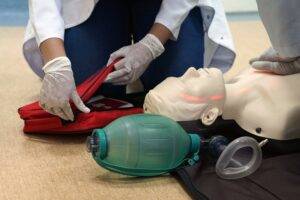What is the Purpose of Basic Life Support: A Clear and Concise Explanation

<?xml encoding=”utf-8″ ?????????>
Basic Life Support (BLS) is a crucial set of medical procedures aimed at providing emergency care in life-threatening situations.
These procedures encompass a range of techniques, including cardiopulmonary resuscitation (CPR) and automated external defibrillator (AED) use, that can be employed by both laypeople and healthcare professionals to act as an intermediary measure until more advanced medical assistance is available. BLS skills are particularly important in instances of sudden cardiac arrest or respiratory distress, as administering timely, effective support can significantly improve a patient’s chance of survival.
Learning BLS is beneficial not only for healthcare professionals, but also for members of the public, as emergencies can occur anytime, anywhere. Training courses focused on teaching BLS techniques equip individuals with the knowledge and skills needed to effectively respond to a wide array of emergencies, such as how to recognise the signs of a heart attack, perform CPR, and intervene in cases of choking. By acquiring these essential capabilities, one can potentially save a life and have a profound impact on the well-being and recovery of the victim.
Understanding Basic Life Support
Basic life support (BLS) is a crucial component of first aid, designed to provide immediate care in emergency situations. It comprises a range of medical procedures and techniques aimed at preserving life until professional help arrives. BLS is vital in cases of cardiac arrest, obstructed airways, or respiratory distress, as these events can rapidly become life-threatening if not addressed promptly.
Fundamentally, BLS entails maintaining a patient’s circulation and respiration. One of the primary methods to achieve this is through cardiopulmonary resuscitation (CPR). By administering chest compressions and rescue breaths, an individual can help maintain blood flow and oxygenation for a patient in cardiac arrest until advanced life support arrives.
In addition to CPR, BLS also involves addressing airway obstruction issues, such as choking or drowning. Immediate action is required to clear the airway and restore normal breathing, emphasising the importance of learning these skills.
Learning BLS is essential for both healthcare professionals and the general public, as every individual is a potential first responder in emergency situations. Ensuring a broad understanding of BLS increases the likelihood of survival for victims of sudden cardiac arrest and other life-threatening emergencies. Resuscitation Council UK regularly updates their guidelines for adult basic life support and provides a wealth of resources to support learning and training.
Significance of Basic Life Support
Basic Life Support (BLS) serves an essential purpose in emergency scenarios where an individual faces life-threatening situations. It comprises medical care techniques performed by bystanders or first responders to help victims who are choking, drowning, or experiencing cardiac arrest. By assisting in maintaining circulation and respiration through Cardiopulmonary Resuscitation (CPR), BLS plays a pivotal role in improving the chances of survival for those in critical situations until advanced life support arrives.
One key aspect of BLS is the ability to administer swift, timely assistance to victims facing cardiac arrest, respiratory distress, or obstructed airways. This prompt response is crucial since every minute that passes without intervention can lead to irreversible brain damage or even death. In this regard, BLS could potentially mean the difference between life and death.
Moreover, BLS offers a fundamental framework for first responders, healthcare providers, and public safety professionals to rely on when confronted with medical emergencies. The standardized algorithm ensures that rescuers are familiar with the actions required and can quickly apply the appropriate techniques in high-pressure situations.
Finally, knowing and comprehending BLS techniques is not limited to professionals. Widespread education in BLS empowers the general public to act as a first line of support during an emergency. Community knowledge of BLS can contribute to an overall improvement in public health and safety outcomes.
Basic Life Support Techniques
Basic Life Support (BLS) involves a set of techniques used to maintain a patient’s circulation and respiration in emergency situations, such as cardiac arrest or respiratory failure. The primary goals of BLS are to establish and maintain an open airway, ensure effective breathing, and support proper blood circulation until advanced medical care arrives.
A core component of BLS is cardiopulmonary resuscitation (CPR), which combines chest compressions and rescue breaths. Chest compressions help to maintain blood flow, while rescue breaths ensure that the patient receives oxygen. To perform CPR effectively, rescuers should follow these steps:
Position the patient on a firm, flat surface.
Place the heel of one hand on the centre of the chest, and the other hand on top, interlocking fingers.
Press down firmly and quickly to a depth of at least 5 cm (2 inches) for adults, allowing the chest to fully recoil between compressions.
Aim for a compression rate of 100-120 compressions per minute.
After 30 compressions, provide two rescue breaths by tilting the head back, lifting the chin, pinching the nose, and breathing into the patient’s mouth.
Another vital BLS technique is the management of choking. Choking occurs when a foreign object obstructs the airway and prevents proper breathing. Rescuers should administer back blows and abdominal thrusts (Heimlich manoeuvre) to help dislodge the object.
Effective communication with emergency services and bystanders is essential in BLS. Rescuers should provide accurate information about the patient’s condition and any treatments provided. This can help to ensure that the patient receives appropriate and timely advanced care.
In summary, Basic Life Support techniques play a crucial role in saving lives during medical emergencies. These methods focus on maintaining circulation and respiration until advanced assistance arrives, thus increasing the patient’s chances of survival.
Primary Goals of Basic Life Support
Preservation of Life
The first and foremost goal of Basic Life Support (BLS) is to preserve life by maintaining the patient’s airway, breathing, and circulation. This is achieved through the use of cardiopulmonary resuscitation (CPR) which involves chest compressions and rescue breaths. By doing so, BLS helps to buy time for the patient until more advanced life support measures can be provided. Early initiation of CPR can significantly increase the chances of survival for the patient.
Prevention of Further Harm
Another key objective of BLS is to minimise the risk of further injury to the patient. When providing BLS, it is crucial for the rescuer to ensure that both they and the patient are in a safe environment. Additionally, the correct technique of CPR must be employed to prevent any further physical harm. For instance, chest compressions should be performed on a hard surface to maximise the efficiency of the compressions and reduce potential injury to the patient. Furthermore, carefully positioning the patient to maintain a clear airway can help prevent respiratory complications.
Promotion of Recovery
Lastly, BLS aims to promote the recovery of the patient. By preserving the patient’s vital functions like circulation and respiration, BLS helps to increase the chances of a successful resuscitation once advanced life support arrives. High-quality CPR and early intervention play an essential role in reducing long-term complications and promoting better recovery outcomes for the patient. It’s important for all individuals, not just healthcare professionals, to be familiar with BLS techniques as prompt intervention can make a significant difference in the patient’s prognosis.
Key Principles of Basic Life Support
Safety
Before beginning any basic life support (BLS) interventions, it is crucial to ensure the safety of both the rescuer and the patient. Evaluate the environment for potential hazards, such as fires or traffic, and remove them if possible or await professional help if the situation is too dangerous.
Assessment
Once the area is safe, assess the patient for responsiveness. Gently shake their shoulders and ask if they are okay. If they are unresponsive or display abnormal breathing, call for emergency assistance immediately.
Recognition
In BLS, one must promptly recognise the signs of cardiac arrest. These signs include unresponsiveness, absence of pulse, and abnormal or absent breathing. The quicker the recognition, the sooner effective cardiopulmonary resuscitation (CPR) can be instituted, increasing the patient’s chances of survival1.
Response
After recognising a cardiac arrest, initiate CPR. Basic life support includes two essential components:
Chest compressions: Perform continuous chest compressions at a rate of 100-120 per minute, to a depth of 5-6cm, to maintain the patient’s circulation until advanced life support arrives.
Rescue breaths: Deliver rescue breaths using a simple airway device or a protective shield, if available. Provide two breaths after every 30 compressions, with each breath lasting one second3.
Following these key principles of basic life support increases the patient’s chances of survival until professional help arrives.
Basic Life Support Training
Basic Life Support (BLS) training aims to equip individuals with the necessary skills and knowledge to respond effectively to cardiac arrest or life-threatening emergencies. Participants learn how to perform cardiopulmonary resuscitation (CPR), which is critical in maintaining the victim’s circulation and respiration. Once advanced life support arrives, victims have a higher chance of survival if BLS has been initiated promptly and correctly.
These courses are structured around the latest resuscitation guidelines, ensuring that trainees master up-to-date techniques and protocols. Emphasis is placed on a systematic approach to carrying out CPR, adhering to established adult and paediatric algorithms. In addition, BLS training encompasses the safe and proper use of Automated External Defibrillators (AEDs), which are vital tools in sudden cardiac arrest scenarios.
BLS training typically covers the following key concepts:
The Chain of Survival – a sequence of critical actions that improve a victim’s chances of survival and recovery
Recognition of cardiac arrest, unconscious breathing, and choking incidents
Appropriate use of chest compressions and rescue breaths
Managing Airway, Breathing, and Circulation (ABC) effectively
Collaboration with emergency medical services (EMS) and handover procedures
Equipped with these skills, individuals who complete BLS training can effectively respond to emergencies and become valuable contributors to public health and safety.
Challenges and Solutions in Basic Life Support
Basic Life Support (BLS) plays a crucial role in managing life-threatening situations, such as choking, drowning or cardiac arrest, until professional medical help arrives. Although BLS techniques can save lives, there are various challenges associated with its implementation and training. This section will discuss these challenges and present potential solutions.
One challenge in BLS training is the need for regular skills refreshment. Since these life-saving techniques are often used in high-pressure situations, retaining proficiency requires consistent practice. To address this issue, BLS courses should enforce periodic refresher training, helping participants maintain their skill level and confidence.
Another challenge lies in the training of deaf individuals, as there may be barriers in communication and course content accessibility. A potential solution is to create tailored courses for the deaf community, employing sign language and visual materials to effectively explain BLS techniques. Furthermore, incorporating adjustable online learning platforms could allow for customised learning experiences, catering to various needs and preferences.
Additionally, bystander apprehension is a common challenge during real-life emergencies. People often hesitate to perform BLS due to factors like fear of causing harm or concerns about legal liability. To overcome this, widespread public education and awareness campaigns should focus on the importance of BLS, emphasising that any intervention is better than none. By doing so, it can encourage more bystanders to take action in emergency situations.
In summary, Basic Life Support plays a vital role in the management of life-threatening situations. Addressing the challenges in BLS training and implementation, through regular refresher courses, tailored training for different communities, and widespread public education, can help increase the effectiveness of BLS techniques and save more lives.




